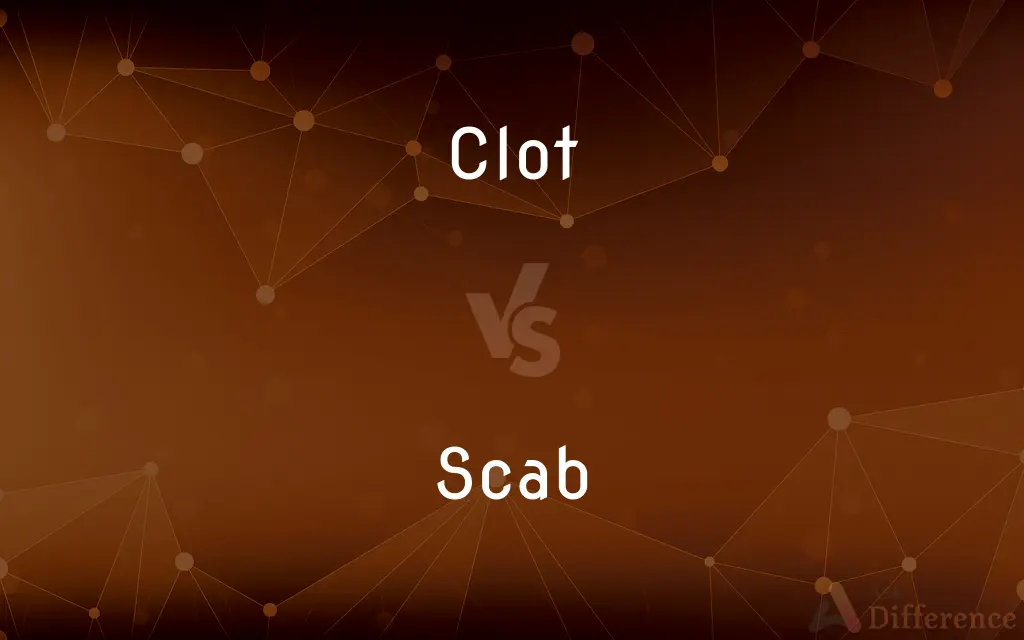Clot vs. Scab — What's the Difference?
By Tayyaba Rehman & Fiza Rafique — Updated on April 23, 2024
A clot forms inside the body to stop bleeding, whereas a scab forms on the skin's surface to protect a wound as it heals.

Difference Between Clot and Scab
Table of Contents
ADVERTISEMENT
Key Differences
Clotting is an internal process that occurs within blood vessels to prevent excessive bleeding when they are damaged. Blood clots are composed of platelets and fibrin, which work together to form a solid mass that plugs the site of injury. This mechanism is crucial for maintaining circulatory system integrity and preventing blood loss during injuries. On the other hand, a scab is the result of the clotting process at the skin's surface, forming a protective crust over a wound. Scabs are made when the blood clot becomes dry and hard, essentially sealing the wound from external threats and aiding in the healing process.
While blood clots can form in response to internal or external vascular injury, scabs specifically form as part of the external wound healing process. The formation of a clot is the body's immediate response to bleeding, acting as a temporary barrier against blood loss. Conversely, scabs provide a longer-term protective barrier, allowing the underlying skin and tissue to regenerate and heal. This distinction highlights their roles at different stages and locations of the healing process.
Clots, while life-saving in their function to stop bleeding, can also pose health risks if they form inappropriately, such as in deep veins or arteries, leading to conditions like deep vein thrombosis or stroke. Scabs, however, do not pose such systemic risks; their main function is protective, and they naturally fall off once the healing process is complete, revealing new skin beneath.
The composition of clots and scabs also differs slightly due to their different roles. Both contain platelets and fibrin, but scabs may also include dead cells, bacteria, and other debris that were present at the wound site. This mixture forms a hard, protective layer as the liquid components evaporate or are reabsorbed by the body, differentiating it from the primarily platelet and fibrin composition of internal clots.
The care and treatment of areas affected by clots and scabs can differ. For clots, medical intervention is often necessary when they pose a risk, involving medications that prevent clot formation or dissolve existing clots. In contrast, scabs require external care to prevent infection and support natural healing, such as keeping the wound clean and avoiding picking at the scab to not disrupt the healing process.
ADVERTISEMENT
Comparison Chart
Location
Inside blood vessels
On the skin's surface
Formation Trigger
Response to internal or external bleeding
Response to external wounds
Primary Function
Stop bleeding, prevent blood loss
Protect wound, aid in healing
Health Risks
Can cause conditions like DVT or stroke if formed inappropriately
Mainly protective, no systemic health risks
Composition
Platelets and fibrin
Platelets, fibrin, dead cells, bacteria
Treatment/Care
May require medications to manage
Requires cleanliness, protection from disruption
Compare with Definitions
Clot
A mass of blood that forms inside vessels to stop bleeding.
A blood clot formed to prevent further bleeding after the injury.
Scab
A hard crust that forms over a wound on the skin.
A scab formed over the scrape, protecting it from infection.
Clot
Triggered by vascular injury, internal or external.
Clotting factors work together to form a clot at the injury site.
Scab
Occurs as a blood clot dries and hardens at a wound's surface.
The scab developed as the wound began to heal.
Clot
Prevents excessive blood loss, crucial for survival.
The clot acted quickly to seal the damaged blood vessel.
Scab
Natural healing process, requires minimal interference.
It's best to let the scab fall off naturally without picking at it.
Clot
Often involves anticoagulants or clot-dissolving drugs.
She was prescribed medication to dissolve the clot.
Scab
Serves as a protective barrier during the healing process.
The scab covers the wound, allowing new skin to grow underneath.
Clot
Can be harmful if it blocks blood flow in vessels.
He was treated for a blood clot that posed a risk of stroke.
Scab
Low, mainly involves care to prevent infection.
Keeping the scab clean is essential for proper healing.
Clot
A thick, viscous, or coagulated mass or lump, as of blood.
Scab
A crust discharged from and covering a healing wound.
Clot
A clump, mass, or lump, as of clay.
Scab
Scabies or mange in domestic animals or livestock, especially sheep.
Clot
A compact group
A clot of trucks blocking the tunnel's entrance.
Scab
Any of various plant diseases caused by fungi or bacteria and resulting in crustlike spots on fruit, leaves, or roots.
Clot
To form into a clot or clots; coagulate
The blood clotted over the wound.
Scab
The spots caused by such a disease.
Clot
To cause to form into a clot or clots.
Scab
(Slang) A person regarded as contemptible.
Clot
To fill or cover with or as if with clots.
Scab
A worker who refuses membership in a labor union.
Clot
A thrombus, solidified mass of blood.
Scab
An employee who works while others are on strike; a strikebreaker.
Clot
A solidified mass of any liquid.
Scab
A person hired to replace a striking worker.
Clot
A silly person.
Scab
To become covered with scabs or a scab.
Clot
(intransitive) To form a clot or mass.
Scab
To work or take a job as a scab.
Clot
(transitive) To cause to clot or form into a mass.
Scab
An incrustation over a sore, wound, vesicle, or pustule, formed during healing.
Clot
A concretion or coagulation; esp. a soft, slimy, coagulated mass, as of blood; a coagulum.
Doth bake the egg into clots as if it began to poach.
Scab
The scabies.
Clot
To concrete, coagulate, or thicken, as soft or fluid matter by evaporation; to become a cot or clod.
Scab
The mange, especially when it appears on sheep.
Clot
To form into a slimy mass.
Scab
(uncountable) Any of several different diseases of potatoes producing pits and other damage on their surface, caused by streptomyces bacteria (but formerly believed to be caused by a fungus).
Clot
A lump of material formed from the content of a liquid
Scab
Common scab, a relatively harmless variety of scab (potato disease) caused by Streptomyces scabies.
Clot
Change from a liquid to a thickened or solid state;
Coagulated blood
Scab
(plant disease) Any one of various more or less destructive fungal diseases that attack cultivated plants, forming dark-colored crustlike spots.
Clot
Cause to change from a liquid to a solid or thickened state
Scab
(founding) A slight irregular protuberance which defaces the surface of a casting, caused by the breaking away of a part of the mold.
Clot
Turn into curds;
Curdled milk
Scab
A mean, dirty, paltry fellow.
Clot
Coalesce or unite in a mass;
Blood clots
Scab
A worker who acts against trade union policies; any picket crosser (strikebreaker), and especially one with devotion to union busting.
Scab
(intransitive) To become covered by a scab or scabs.
Scab
(intransitive) To form into scabs and be shed, as damaged or diseased skin.
Scab
(transitive) To remove part of a surface (from).
Scab
(intransitive) To act as a strikebreaker.
Scab
To beg (for), to cadge or bum.
I scabbed some money off a friend.
Scab
An incrustation over a sore, wound, vesicle, or pustule, formed by the drying up of the discharge from the diseased part.
Scab
The itch in man; also, the scurvy.
Scab
The mange, esp. when it appears on sheep.
Scab
A disease of potatoes producing pits in their surface, caused by a minute fungus (Tiburcinia Scabies).
Scab
A slight irregular protuberance which defaces the surface of a casting, caused by the breaking away of a part of the mold.
Scab
A mean, dirty, paltry fellow.
Scab
A nickname for a workman who engages for lower wages than are fixed by the trades unions; also, for one who takes the place of a workman on a strike.
Scab
Any one of various more or less destructive fungus diseases attacking cultivated plants, and usually forming dark-colored crustlike spots.
Scab
To become covered with a scab; as, the wound scabbed over.
Scab
To take the place of a striking worker.
Scab
Someone who works (or provides workers) during a strike
Scab
The crustlike surface of a healing skin lesion
Scab
Form a scab;
The wounds will eventually scab
Scab
Take the place of work of someone on strike
Common Curiosities
What causes a clot to form?
A clot forms as a response to bleeding due to vascular injury, involving platelets and fibrin to prevent blood loss.
Why does a scab form?
A scab forms on the skin's surface over a wound to protect it from infection and aid in the healing process.
Can picking at a scab cause harm?
Yes, picking at a scab can reopen the wound, delay healing, and increase the risk of infection or scarring.
Can all clots lead to serious conditions?
Not all clots are dangerous; their risk depends on their location and size. Clots vital for healing minor injuries are usually harmless.
Is it normal for a scab to itch?
Yes, it's normal for a scab to itch as the wound heals underneath. It's important not to scratch it to allow healing to continue.
How can I care for a scab?
Care for a scab by keeping the wound clean and avoiding picking at it to prevent infection and allow natural healing.
Should I remove a scab if it appears loose?
It's best to let a scab fall off naturally to ensure the wound underneath has healed sufficiently.
Can clots be dangerous?
Yes, clots can be dangerous if they block blood flow in important vessels, potentially leading to conditions like strokes or deep vein thrombosis (DVT).
What's the difference between a clot and a scab?
The main difference is their location and function: clots form inside blood vessels to stop bleeding, while scabs form on the skin's surface to protect wounds during healing.
How are clots treated?
Clots may require medical treatment with anticoagulants or clot-dissolving medications, especially if they pose a risk to health.
How does the body dissolve clots?
The body uses natural processes and enzymes, such as plasmin, to break down and dissolve clots once the healing process progresses.
What signs indicate a clot might be dangerous?
Signs like swelling, pain, redness, or warmth around the clot site, especially in the legs or if experiencing difficulty breathing, could indicate a dangerous clot.
Share Your Discovery

Previous Comparison
Ambitious vs. Hardworking
Next Comparison
Coverage vs. BroadcastAuthor Spotlight
Written by
Tayyaba RehmanTayyaba Rehman is a distinguished writer, currently serving as a primary contributor to askdifference.com. As a researcher in semantics and etymology, Tayyaba's passion for the complexity of languages and their distinctions has found a perfect home on the platform. Tayyaba delves into the intricacies of language, distinguishing between commonly confused words and phrases, thereby providing clarity for readers worldwide.
Co-written by
Fiza RafiqueFiza Rafique is a skilled content writer at AskDifference.com, where she meticulously refines and enhances written pieces. Drawing from her vast editorial expertise, Fiza ensures clarity, accuracy, and precision in every article. Passionate about language, she continually seeks to elevate the quality of content for readers worldwide.















































